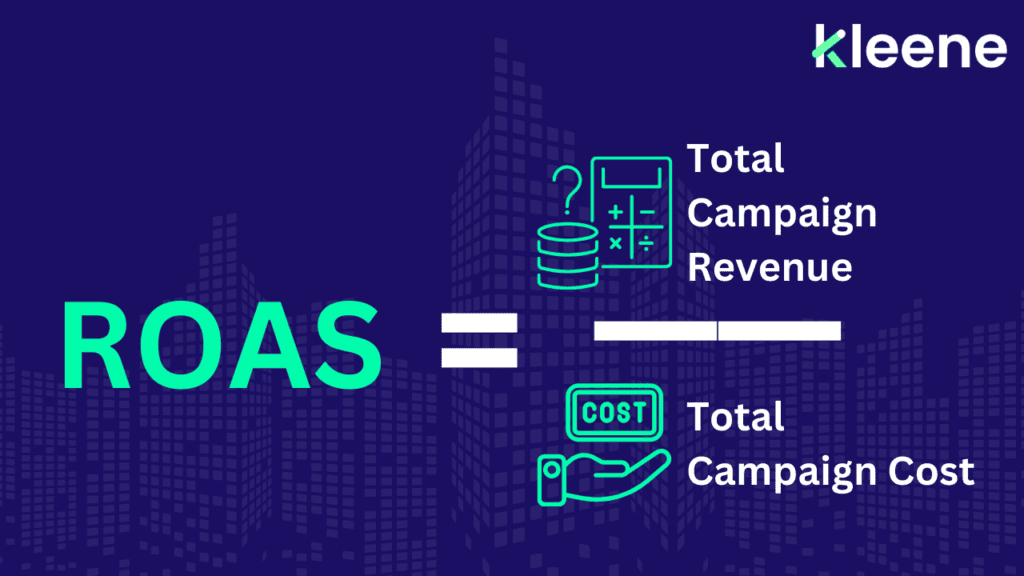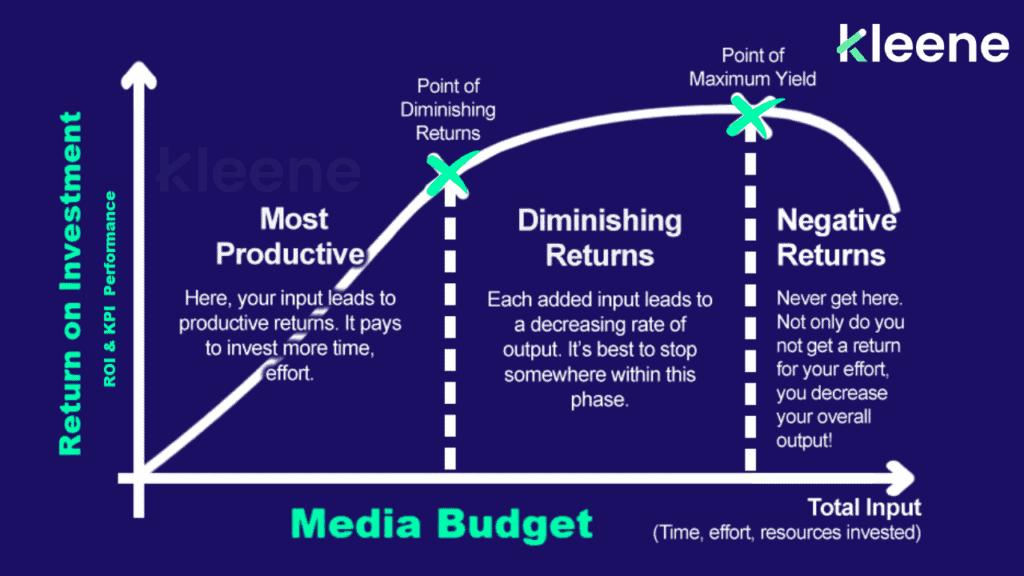Calculating your return on ad spend (ROAS) is crucial for any business looking to optimize its marketing budget and drive growth. In this comprehensive guide, we’ll delve into how to calculate your return on ad spend and ensure your campaigns are as effective as possible. Understanding and improving ROAS is key to making informed marketing decisions that contribute to your company’s bottom line.
What is Return on Ad Spend?
ROAS is a marketing metric that measures the revenue generated for every dollar spent on advertising. It’s a critical indicator of the effectiveness of your advertising campaigns. A higher return on ad spend means a more profitable campaign, while a lower return on ad spend indicates a need for optimization.
How to Calculate Return on Ad Spend
To calculate ROAS, use the following formula:

For example, if you spent £1,000 on an advertising campaign and generated £5,000 in revenue from that campaign, your return on ad spend would be:
ROAS=£5,000/£1,000=5
This means that for every pound spent on advertising, you earned five pounds in revenue.
Why Black Box Solutions Don’t Work
Relying on generic, one-size-fits-all solutions for calculating ROAS is not effective. Each business has unique needs and goals, and a tailored approach is essential for accurate measurement. Black box solutions lack the specificity required to account for individual business nuances, leading to inaccurate return on ad spend calculations and misguided strategies.
The Need for Tailored Measurement Tools
To accurately measure and optimize your return on ad spend, you need a tool tailored to your business’s unique characteristics. This ensures that all relevant data points are considered, leading to more precise insights and better decision-making.
The Importance of Full Channel Measurement
Without a comprehensive measurement tool, companies cannot accurately gauge their brand spending or understand how to allocate resources efficiently. A full channel measurement tool considers all advertising channels, providing a holistic view of your marketing performance.
Allocating Resources Efficiently
Effective resource allocation is vital for maximizing return on ad spend. By understanding the impact of each advertising channel, businesses can strategically shift budgets to the most effective campaigns, ensuring every pound spent contributes to higher returns.

Utilizing Predictive Models for Better Forecasting
A marketing spend optimization tool that not only measures the impact of each channel but also uses predictive models is crucial. These models forecast the impact of budget shifts on ROAS, customer acquisition cost (CAC), and customer lifetime value (LTV), enabling more strategic allocation decisions.
Strategic Allocation Decisions
Predictive models provide insights into how changes in budget allocation can impact your ROAS. By leveraging these insights, businesses can make informed decisions that drive higher return on ad spend and overall profitability.
Incorporating Offline and Online Touchpoints
Accurately predicting and calculating return on ad spend requires a measurement tool that considers all touchpoints, both offline and online. Ignoring any part of the customer journey can lead to incomplete data and inaccurate return on ad spend calculations.
Comprehensive Touchpoint Analysis
A comprehensive analysis of all touchpoints ensures that every interaction contributing to a sale is accounted for. This holistic approach leads to a more accurate calculation of return on ad spend and better optimization strategies.
10 Proven Strategies to Maximize Your Return on Ad Spend
- Tailored Measurement Tools: Use tools tailored to your unique business needs to get accurate return on ad spend calculations.
- Full Channel Measurement: Ensure your measurement tool covers all advertising channels for a comprehensive view of performance.
- Predictive Models: Utilize predictive models to forecast the impact of budget shifts on ROAS, CAC, and LTV.
- Offline and Online Touchpoints: Consider all touchpoints in the customer journey for accurate ROAS calculations.
- Resource Allocation: Allocate resources efficiently based on the performance of each advertising channel.
- Continuous Optimization: Regularly review and optimize your ad campaigns to improve return on ad spend.
- Audience Targeting: Target the right audience to increase the effectiveness of your ad spend.
- Ad Quality: Ensure high-quality ads that resonate with your audience to drive higher returns.
- Budget Management: Manage your budget wisely to maximize ROAS.
- Data-Driven Decisions: Use data-driven insights to make informed decisions about your marketing strategy.

Conclusion
Calculating and optimizing your return on ad spend is essential for any business aiming to maximize the effectiveness of its advertising budget. By using tailored measurement tools, incorporating full channel analysis, leveraging predictive models, and considering all touchpoints, you can ensure accurate ROAS calculations and make strategic decisions that drive growth. Understanding and improving your ROAS is a continuous process that requires careful analysis and optimization, but the rewards are well worth the effort.
ROAS is not just a metric; it’s a powerful tool that, when used correctly, can significantly enhance your marketing strategy and boost your business’s profitability. With the right approach and tools, you can achieve impressive returns on your advertising investments, driving sustained growth and success.
Next Steps for increasing ROAS
Integrating cutting-edge technological platforms, such as Kleene’s Decision Intelligence Platform, can make it easier for Chief Marketing Officers to implement Marketing Mix Modelling and ensure ROI.
By streamlining the implementation of Marketing Mix Modelling , our platform enables Marketing teams to access deeper insights more efficiently and effortlessly. This efficiency is achieved through:
- Comprehensive Data Integration: Our platform excels in aggregating a wide array of data sources, including sales, marketing, consumer behaviour analytics, finance, and logistics. This extensive integration facilitates a more thorough and accurate analysis.
- Holistic Campaign Analysis: The platform is adept at measuring the impact of both online and offline campaigns, ensuring a comprehensive view of marketing efforts. Enhanced Insights from Comprehensive Data: with the inclusion of diverse data sets, the platform provides richer insights, enabling more informed decision-making
- User-Friendly Interface: Kleene’s platform is designed with user experience in mind, allowing CMOs and their teams to navigate complex data analytics with ease. This simplifies the process of deriving actionable insights from MMM results.
- Exceptional Support and Expertise: Kleene partners with clients to ensure a significant return on investment and effective implementation of the platform, providing unparalleled support and expertise.
Contact a Kleene.ai data expert to learn more about how their Decision Intelligence Platform can help your company get a better ROAS
You may also like:
7 Powerful Tips on How to Work Out ROAS Accurately
The Ultimate Guide to ROAS Marketing: 7 Powerful Tips to Master ROAS
ROAS Formula: 7 Effective Strategies to Amplify Your Advertising Returns
How to Calculate ROAS in 2024: A Comprehensive Guide to Maximising Your Return on Ad Spend
Frequently Asked Questions About Return on Ad Spend
- What is a good return on ad spend? A good ROAS varies by industry and business model, but generally, a ROAS of 4:1 or higher is considered excellent. This means you earn four pounds for every pound spent on advertising.
- How is return on ad spend calculated? It is calculated by dividing the revenue generated from ads by the cost of the ads. The formula is ROAS = Revenue from Ads / Cost of Ads.
- What is the average return on ad spend? The average return on ad spend depends on the industry, but it typically ranges from 3:1 to 5:1. This means that for every pound spent on advertising, you earn between three and five pounds.
- What is the formula for return on ad spend? The formula Is simple: ROAS = Revenue from Ads / Cost of Ads. This formula helps you understand the profitability of your advertising campaigns.
- How can I use a return on ad spend calculator? A return on ad spend calculator simplifies the process by automatically calculating ROAS based on your inputted revenue and ad spend figures. These tools are useful for quickly assessing the performance of your campaigns.
- Why is measuring return on ad spend important? It is crucial for understanding the effectiveness of your advertising campaigns and making data-driven decisions to optimize future spending. It helps you determine which campaigns are profitable and which need improvement.
- How can I improve my return on ad spend? Improving your return on ad spend involves optimizing your ad campaigns, targeting the right audience, and reallocating your budget to the most effective channels. Regularly reviewing and adjusting your strategy based on performance data is key.
- What factors influence return on ad spend? Several factors influence return on ad spend, including ad quality, targeting accuracy, budget allocation, and overall marketing strategy. Understanding these factors can help you improve your ROAS.
- What tools can help measure return on ad spend? Tools that offer comprehensive data analysis, predictive modeling, and full channel measurement can help accurately measure and optimize return on ad spend. These tools provide insights that are crucial for making informed decisions.
- How does Google Ads return on ad spend work? Google Ads provides metrics to track the performance of your campaigns, helping you calculate and optimize your return on ad spend. By analyzing these metrics, you can adjust your campaigns to improve profitability.
By following these strategies and utilizing the right tools, businesses can effectively measure, optimize, and maximize their return on ad spend, leading to greater profitability and growth.



